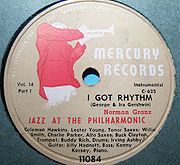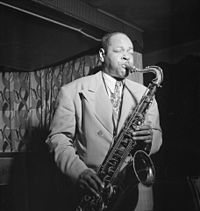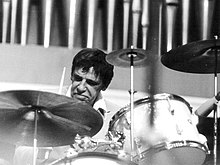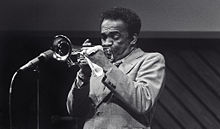Bird and Pres - The '46 Concerts Jazz at the Philharmonic
| Bird And Pres - The '46 Concerts Jazz At The Philharmonic | |
|---|---|
| Live album from Charlie Parker , Lester Young | |
|
Publication |
1950 |
| Label (s) | Clef Records , Verve Records |
|
Format (s) |
LP, compact disc |
|
Title (number) |
7th |
|
running time |
72:25 (CD) |
| occupation |
|
|
Studio (s) |
Live recordings from Los Angeles and New York City |
Jazz At The Philharmonic - Bird And Pres - The '46 Concerts is a jazz album by Charlie Parker , Lester Young and other musicians such as Coleman Hawkins , which contains live recordings of three Jazz at the Philharmonic concerts, which took place from January to April Were recorded in 1946. This first appeared on Norman Granz 'label Clef , later on Verve Records .
The album
The JATP concerts in January 1946
Charlie Parker and Dizzy Gillespie had a long engagement in the Billy Berg jazz bistro in Hollywood at the turn of 1945/46. In the recording sessions with Californian musicians, also organized by Norman Granz in early 1946, Charlie Parker and his idol Lester Young (“Pres”) met for the first time. The tenor saxophonist had just been released for drug abuse after spending 15 months in a prison camp; In the opinion of Parker biographers Peter Niklas Wilson and Ulfert Goeman, Prez was “shockingly apathetic to Charlie Parker's first major jazz concert, and he hardly noticed Parker.” Many critics believe that Lester Young had previous experiences in the Army broken; he seems confused and unimaginative in the January session at hand when the tracks Crazy Rhythm and The Man I Love were recorded.
On January 29th Granz had Charlie Parker and Lester Young re-record the standard Sweet Georgia Brown , further wind players were the trumpeters Dizzy Gillespie and Al Killian and the saxophonists Charlie Ventura and Willie Smith , in the rhythm section sat the pianist Mel Powell and the bassist Billy Hadnott and drummer Buddy Rich . Prez was in little better shape; Wilson / Goeman, on the other hand, wrote about Charlie Parker's play: It "surprises his forced swing, with a directness and an almost grim persistence that clearly stands out from Lester Young's indifferent play." The recording of the piece fades into the current concert shortly before Parker's solo, when pianist Mel Powell delivers his contribution; after Parker comes the solo Lester Youngs, followed by Dizzy Gillespie.
Another concert recording with four numbers was also made in January 1946 in the Philharmonic Auditorium in Los Angeles; for Gillespie came the trumpeter Howard McGhee , for Mel Powell the pianist Arnold Ross . The recording begins with the session-like Blues for Norman , a pounding “ Kansas City Blues , angular and rough, full of Parker's passion. Lester Young also feels more at home here. His improvisations are colorful, intense and perfectly balanced. The other soloists such as the alto saxophonist Willie Smith and the two trumpeters Howard McGhee and Al Killian provide variety. "
The Vernon Duke standard I Can't Get Started initially has a long, quiet solo by Lester Youngs, which Parker immediately follows with his ballad play; What was striking here was the “clear contrast between Parker and Willie Smith, who played smoothly and rhythmically conservatively”.
The highlight of the January 1946 jam session was Charlie Parker's solo on Oh, Lady Be Good! ; the eleven-minute game about George Gershwin's classic is initiated by Arnold Ross, until after one minute Charlie Parker kicks in. Over the course of the evening, Down Beat magazine honored Willie Smith as best alto saxophonist and Charlie Ventura as best tenor, while Charlie Parker and Lester Young were not even mentioned. "That was reason enough for both of them to playfully outdo their opponents in 'Lady Be Good' and to show the true hierarchy in front of the live audience". Wilson and Goeman see Parker's contribution as one of the best Parker solos ever; they quote the impression of pianist John Lewis : “Bird turned 'Lady Be Good' into blues . His solo made all the other musicians on stage look like old men ”. The audience in the Philharmonic Auditorium raged and danced in the corridors, which led to the fact that those responsible forbade Norman Granz to hold further events there.
The JATP concert in April 1946

In April 1946, Coleman Hawkins came to California to take part in other JATP concerts that were to mark the start of a nationwide tour that ended in New York's Carnegie Hall in late May . The concert took place on April 22nd at the Embassy Theater ; the name Jazz at the Philharmonic was retained. The only trumpeter this time was Buck Clayton , who had just been discharged from the US Army; guitarist Irving Ashby also took part. On April 22nd, the JATP Blues was recorded in Los Angeles , with a series of impressive solos, with a friendly playing Lester Young, followed by a more aggressive Hawkins, whose solo rose to the highest registers, which the audience disliked. wrote the Hawkins biographer John Chilton. Another of these blowing sessions on the tour was later called Slow Drag ; The fantasy name NG Shrdlu was given as the author , nom de plume for Norman Granz.
Humphrey Lyttelton wrote of the event: “In this noisy arena, it was the extroverted Hawkins who played gleefully and collected in his calm, inimitable way without any special concessions to the audience, while the introverted“ cool ”Lester honked in and riffs the ecstasy drove ”.

The swinging JATP blues begins with a solo by Coleman Hawkins, followed by Parker and Lester Young; then guitarist Irving Ashby , pianist Kenny Kersey and Buddy Rich have the opportunity to introduce themselves as soloists. I Got Rhythm works in a similar way , to which Norm Granz first introduces the band.
Hawkins biographer Teddy Doering commented on the two recordings: “At the concert in Los Angeles there was an impressive selection of saxophonists on stage - Hawk and Lester as well as Bird and Willie Smith. Contrast was the order of the day, but the confrontation or rivalry between Hawkins and Lester did not fully come into play. Both play their solos as if the other weren't there. Hawkins is powerful and swinging in the fast pieces ( JATP Blues and I Got Rhythm ), but without any particular finesse. Lester Young, on the other hand, shows his qualities; against Hawkins' powerful tone, he sets his cool conception with rhythmic peculiarities. The star of the session is undoubtedly Charlie Parker ”.
Rating of the album

According to the authors Wilson and Goeman, the recordings from the early days of West Coast jazz with a mixture of bebop and swing and because of the casual encounter of the jazz greats Parker, Gillespie, Young, Hawkins and Smith are unique and a rarity.
The critic of all music saw Charlie Parker's performances with the Jazz at the Philharmonic in January and April 1946 in his own element. He mentions that from his early years in Kansas City, Parker, during the 1930s, practiced woodshedding - the term referring to the discipline of incessant public play - with highly competent musicians. The JATP method worked in a similar way: Unfortunately, the saxophonist was completely absent in the next few months of 1946 after the failed Lover Man on July 29, 1946 was created during his recording sessions for Dial Records in Hollywood ; it is like a "distant cry for those excellent JATP public jam sessions ."
Ken Dryden wrote - also in Allmusic , where the album was rated with four stars - about the concert recordings that they were truly all-star events. The performances at the April Show were also exceptional, when Coleman Hawkins and Buck Clayton, who joined them, fought out an old-style jam session on stage; in the opening JATP Blues , Parker and Hawkins outshine everyone else, while in I Got Rhythm things are different and the group is more lively. As in the later Jazz at the Philharmonic shows, the rhythm section is only average, apart from Mel Powell's contributions to "Sweet Georgia Brown".
title

- Jazz At The Philharmonic - Bird and Pres - The '46 Concerts (Verve VE2 2518)
- Sweet Georgia Brown (Kenneth Casey, Maceo Pinkard , Ben Barnie ) 9:32
- Blues for Norman 8:37
- I Can't Get Started (Ira Gershwin, Vernon Duke ) 9:15
- Oh Lady be Good (George & Ira Gershwin) 11:05
- After You've Gone ( Henry Creamer , Turner Layton) 7:33
- I Got Rhythm (George & Ira Gershwin) 12:54
- Introductions by Norman Granz / JATP Blues 2: 16/10: 56
Editorial notes
Like the other titles, Sweet Georgia Brown appeared in two parts on the 78 records by Mercury and Clef. Coupled with other pieces from the January and April concerts, the recordings then appeared on the 10-inch LPs by Mercury and Clef; Jazz At The Philharmonic, Vol. 3 (Mercury MG 35004, MG VOL.3, MG VOL.3 × 45; Clef MG VOL.3) or on the Clef-10-Inch-LP MGC 608 as Lady be Good . Lady Be Good and After You've Gone also appeared - coupled with later recordings of a JATP tour in October - on the album JATP - How High the Moon (MGC 608).
The recordings were then released on a 12-inch LP under the title Bird and Prez - The '46 Concert Jazz at the Philharmonic (Verve VE 2-2518). Later editions also appeared under the titles
- Jazz At The Philharmonic , Vol. 2 (Verve MG VOL.2)
- Lester Young At JATP (Verve VSP 41)
- Jazz At The Philharmonic - How High The Moon (Mercury MGC 608; Clef MGC 608)
- Jazz At The Philharmonic, Vol. 1 (Verve MG VOL.1)
- The Charlie Parker Story, # 3 (Verve MGV 8002)
- The Charlie Parker Story (Verve MGV 8100-3)
- Charlie Parker - Return Engagement (Verve V3HB 8840)
- Jazz At The Philharmonic, Vol. 2 (Mercury MG 35003, MG VOL.2, MG VOL.2 × 45; Clef MG VOL.2)
Session sequence
- Dizzy Gillespie, Al Killian (tp) Charlie Parker, Willie Smith (as) Charlie Ventura, Lester Young (ts) Mel Powell (p) Billy Hadnott (kb) Lee Young (dr)
Philharmonic Auditorium , Los Angeles, CA, January 28, 1946
- Sweet Georgia Brown
- Al Killan, Howard McGhee (tp) Charlie Parker, Willie Smith (as) Lester Young (ts) Arnold Ross (p) Billy Hadnott (kb) Lee Young (dr)
Philharmonic Auditorium , Los Angeles, January 1946
- Blues For Norman
- I can't get started
- Lady Be Good
- After you've gone
- Buck Clayron (tp) Charlie Parker, Willie Smith (as) Lester Young, Coleman Hawkins (ts) Kenny Kersey (p) Irving Ashby (git) Billy Hadnott (kb) Buddy Rich (dr)
Embassy Hotel , Los Angeles, April 22, 1946
- I got rhythm
- JATP blues
literature
- John Chilton : The Song of the Hawk - The Life and Recordings of Coleman Hawkins. The University of Michigan Press, Ann Arbor MI 1993, ISBN 0-472-08201-9 .
- Teddy Doering: Coleman Hawkins - His life, his music, his records (= Collection Jazz. Vol. 26). Oreos, Waakirchen 2001, ISBN 3-923657-61-7 .
- Ross Russell : Bird Lives! The story of Charlie "Yardbird" Parker. Hannibal Verlag, Vienna 1985, ISBN 3-85445-020-6 .
- Peter Niklas Wilson , Ulfert Goeman: Charlie Parker - His life, his music, his records (= Collection Jazz ). Oreos, Schaftlach 1988, ISBN 3-923657-12-9 .
Web links
Individual evidence
- ↑ Quoted from Wilson / Goeman, p. 96.
- ^ After Wilson, Goeman, p. 96.
- ^ Cit. Wilson, Goeman, p. 96.
- ↑ Quoted from Wilson, Goeman, p. 97.
- ↑ Quoted from Wilson / Goeman, p. 96.
- ↑ Quoted from Wilson / Goeman, p. 97.
- ↑ Quoted from Wilson / Goeman, p. 97.
- ^ Chilton, p. 236.
- ↑ Quoted from Doering, p. 51
- ↑ Quoted from Doering, p. 161.
- ↑ After the JATP Blues and I Got Rhythm the band played - but without Parker - the tracks I Surrender Dear , I Found a New Baby and Bagle Call Rag ; see. Goeman, p. 161.
- ^ Cit. Wilson / Goeman, p. 97.
- ↑ arwulf After Arwulf, All Music Guide
- ↑ Quoted from Dryden, Allmusic.
- ↑ Notes to jazzdisco.org.


